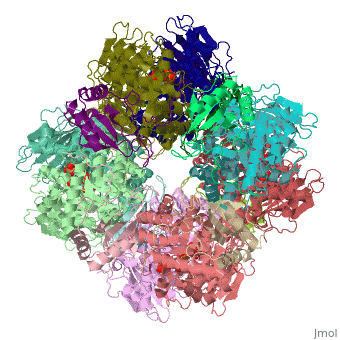Calvin cycle
From Proteopedia
(Difference between revisions)
| Line 36: | Line 36: | ||
6) Sedoheptulose-1,7-bisphosphatase (one of only three enzymes of the Calvin cycle that are unique to plants) cleaves sedoheptulose-1,7-bisphosphate into <scene name='94/945512/Cv/1'>sedoheptulose-7-phosphate</scene>, releasing an inorganic phosphate ion into solution | 6) Sedoheptulose-1,7-bisphosphatase (one of only three enzymes of the Calvin cycle that are unique to plants) cleaves sedoheptulose-1,7-bisphosphate into <scene name='94/945512/Cv/1'>sedoheptulose-7-phosphate</scene>, releasing an inorganic phosphate ion into solution | ||
| - | 7) Fixation of a third CO2 generates two more G3P. The ketose S7P has two carbons removed by [[transketolase]], giving <scene name='94/945512/Cv/2'>ribose-5-phosphate (R5P)</scene>, and the two carbons remaining on transketolase are transferred to one of the G3P, giving another <scene name='94/942630/Cv/4'>Xu5P</scene>. This leaves one G3P as the product of fixation of 3 CO2, with generation of three pentoses that can be converted to Ru5P. | + | 7) Fixation of a third CO2 generates two more G3P. The ketose S7P has two carbons removed by [[transketolase]], giving <scene name='94/945512/Cv/2'>ribose-5-phosphate (R5P)</scene>, and the two carbons remaining on transketolase are transferred to one of the <scene name='39/392339/Cv1/4'>G3P</scene>, giving another <scene name='94/942630/Cv/4'>Xu5P</scene>. This leaves one G3P as the product of fixation of 3 CO2, with generation of three pentoses that can be converted to Ru5P. |
</StructureSection> | </StructureSection> | ||
== References == | == References == | ||
<references/> | <references/> | ||
Revision as of 11:11, 3 January 2023
| |||||||||||

